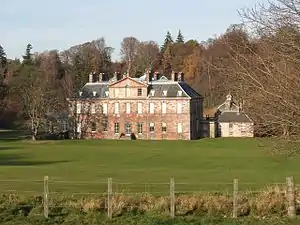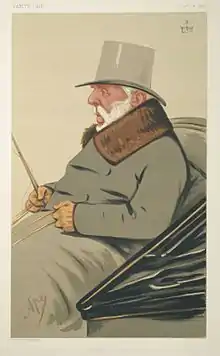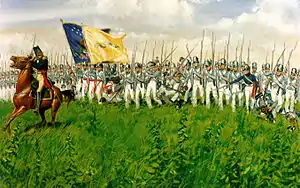George Hay, 8th Marquess of Tweeddale
Field Marshal George Hay, 8th Marquess of Tweeddale KT GCB (1 February 1787 – 10 October 1876) was a Scottish soldier and administrator. He served as a staff officer in the Peninsular War under Arthur Wellesley and was with Wellesley at the Second Battle of Porto when they crossed the Douro river and routed Marshal Soult's French troops in Porto. Hay also saw action at the Battle of Bussaco and at the Battle of Vitoria. He later served in the War of 1812 and commanded the 100th Regiment of Foot at the Battle of Chippawa when he was taken prisoner of war. He went on to become governor of Madras and, at the same time, Commander-in-Chief of the Madras Army, in which role he restored the discipline of the army, which had been allowed to fall into a relaxed state.
The Marquess of Tweeddale | |
|---|---|
_-_George_Hay_(1787%E2%80%931876)%252C_8th_Marquess_of_Tweeddale%252C_Agriculturist_-_PG_1571_-_National_Galleries_of_Scotland.jpg.webp) The 8th Marquess of Tweeddale | |
| Born | 1 February 1787 Bonnington, Scotland |
| Died | 10 October 1876 (aged 89) Yester, Scotland |
| Buried | |
| Allegiance | |
| Service/ | |
| Years of service | 1804 – 1848 |
| Rank | Field Marshal |
| Commands held | Madras Army |
| Battles/wars | Peninsular War War of 1812 |
| Awards | Knight of the Order of the Thistle Knight Grand Cross of the Order of the Bath |

Life and military career
Born at Yester House the eldest son of George Hay, 7th Marquess of Tweeddale and Lady Hannah Charlotte Maitland (a daughter of James Maitland, 7th Earl of Lauderdale), Hay was educated at the Royal High School in Edinburgh and commissioned as an ensign in the 52nd Light Infantry in June 1804.[1] After succeeding to his father's title as Marquess of Tweeddale in August 1804, he was promoted to lieutenant on 12 October 1804 and, having received his first training under Sir John Moore at Shorncliffe,[2] he served as an aide-de-camp in Sicily in 1806.[3] He transferred to the Grenadier Guards with the rank of lieutenant in the regiment and captain in the Army on 12 May 1807.[3]

Hay served as a staff officer in the Peninsular War under Arthur Wellesley.[3] Hay was with Wellesley at the Second Battle of Porto in May 1809 when they crossed the Douro river in a daylight coup de main and routed Marshal Soult's French troops in Porto.[2] He was deputy assistant quartermaster general and was wounded at the Battle of Bussaco in September 1810 and, having been promoted to major in the 41st Regiment of Foot, he was assistant quartermaster general at the Battle of Vitoria in June 1813.[4] He was immediately promoted to lieutenant colonel.[3]
Hay also served in the War of 1812 between Britain and America, and commanded the 100th Regiment of Foot at the Battle of Chippawa in July 1814.[3] As the redcoats of the 1/1st (Royal Scots) Foot and 100th Regiments moved forward, their own artillery had to stop firing in order to avoid hitting them. Meanwhile, the American gunners switched from firing roundshot to firing canister, with lethal consequences for the British infantry. Once the opposing lines had closed to less than 100 yards apart, General Winfield Scott of the United States Army advanced his wings, forming his brigade into a "U" shape which allowed his flanking units to catch the British advancing troops in a heavy crossfire.[5] Hay made an attempt to fight to the death but was taken prisoner of war by the Americans.[3] He was appointed Companion of the Order of the Bath in 1815.[1] After the War he returned to Scotland and improved his family estate at Yester.[3] From 1818 to 1820 he served as Pro-Grand Master of the Grand Lodge of Scotland.[6] He was elected a representative peer for Scotland in July 1818, appointed Knight of the Thistle in 1820 and became Lord Lieutenant of East Lothian in February 1823.[7] He was also promoted to colonel on 27 May 1825[8] and to major-general on 10 May 1837.[9] Meanwhile, on his estate, he developed an improved method of making tiles for draining which was patented in October 1839.[10]
In 1842 Hay returned to public service when he was appointed governor of Madras and also, by special arrangement of the Duke of Wellington, Commander-in-Chief of the Madras Army.[1] In that role he restored the discipline of the army, which had been allowed to fall into a relaxed state.[2] Promoted to lieutenant general on 9 November 1846,[11] he retired from active service and returned to his estate in Scotland again in 1848.[3] He was promoted to full general on 20 June 1854[12] and invited to join a Royal Commission established in July 1858 to inquire into the organization of the army then serving under the East India Company.[13] He was advanced to Knight Commander of the Order of the Bath on 9 November 1862[14] and to Knight Grand Cross of the Order of the Bath on 13 March 1867[15] before being further promoted to field marshal on 29 May 1875.[16]
Hay also served as colonel of the 30th Regiment of Foot,[17] then of the 42nd Regiment of Foot[18] and finally of the 2nd Regiment of Life Guards.[19] A strong man, he once drove the mail coach from London to Haddington without a halt or a rest.[2] He died, following injuries sustained during a fire at his home,[2] at Yester House on 10 October 1876 and was buried in the family burial vault at the Church of St. Cuthbert at Yester in Scotland.[1]

Family
In 1816 he married Lady Susan Montagu, a daughter of the 5th Duke of Manchester: they had six sons and eight daughters:[20]
- Lady Susan Georgiana Hay (13 March 1817 – 6 May 1853), married the 1st Marquess of Dalhousie and had issue
- Lady Hannah Charlotte Hay (12 Apr 1818 – 10 November 1887), married Simon Watson Taylor and had issue
- Lady Louisa Jane (29 Jul 1819 – 9 September 1882), married Robert Ramsay and had issue
- Lady Elizabeth (27 September 1820 – 13 August 1904), married the 2nd Duke of Wellington
- George, Earl of Gifford (22 April 1822 – 22 December 1862)
- Lady Millicent (1823–1826), died young
- Lord Arthur, later Earl of Gifford and later 9th Marquess of Tweeddale (9 November 1824 – 29 December 1878)
- Lord William Montagu, later 10th Marquess of Tweeddale (27 January 1826 – 25 November 1911)
- Lord John (23 August 1827 – 4 May 1916)
- Lady Jane (1830 – 13 December 1920), married Sir Richard Taylor and had issue
- Lady Julia (1831–1915)
- Lord Charles Edward (1833–1912)
- Lord Frederick (1835–1912)
- Lady Emily (1836 – 4 April 1924), married Sir Robert Peel, 3rd Baronet and had issue
References
- "George Hay, 8th Marquess of Tweeddale". Oxford Dictionary of National Biography. Retrieved 8 December 2013.
- "The Hays of Tweeddale". Electric Scotland. Retrieved 8 December 2013.
- Heathcote, p. 173
- "George Hay, 8th Marquess of Tweeddale". The Peerage. Retrieved 8 December 2013.
- Elting, p. 186
- "No. 17430". The London Gazette. 12 December 1818. p. 2224.
- "No. 17898". The London Gazette. 22 February 1823. p. 292.
- "No. 18141". The London Gazette. 28 May 1825. p. 927.
- "No. 19456". The London Gazette. 10 January 1837. p. 64.
- "No. 19783". The London Gazette. 29 October 1839. p. 2018.
- "No. 20660". The London Gazette (Supplement). 10 November 1846. p. 3987.
- "No. 21564". The London Gazette. 22 June 1854. p. 1932.
- "No. 22162". The London Gazette. 16 July 1858. p. 3285.
- "No. 22679". The London Gazette. 10 November 1862. p. 5343.
- "No. 23230". The London Gazette. 15 March 1867. p. 1724.
- "No. 24213". The London Gazette. 29 May 1875. p. 2851.
- "No. 20571". The London Gazette. 13 February 1846. p. 529.
- "No. 22610". The London Gazette. 21 March 1862. p. 1536.
- "No. 22776". The London Gazette. 2 October 1863. p. 4742.
- "George Hay, 8th Marquess of Tweeddale". Scottish War Memorials Project. Retrieved 8 December 2013.
Sources
- Elting, John R (1995). Amateurs to Arms: A military history of the war of 1812. New York: Da Capo Press. ISBN 0-306-80653-3.
- Heathcote, Tony (1999). The British Field Marshals, 1736–1997: A Biographical Dictionary. Barnsley: Leo Cooper. ISBN 0-85052-696-5.
| Wikimedia Commons has media related to George Hay, 8th Marquess of Tweeddale. |
| Masonic offices | ||
|---|---|---|
| Preceded by Sir John Marjoribanks, Bt |
Pro-Grand Master of the Grand Lodge of Scotland 1818–1820 |
Succeeded by The Duke of Hamilton (as Grand Master) |
| Political offices | ||
| Preceded by The Lord Elphinstone |
Governor of Madras 1842–1848 |
Succeeded by Henry Pottinger |
| Military offices | ||
| Preceded by Sir Samuel Whittingham |
C-in-C, Madras Army (while serving as Governor) 1842–1848 |
Succeeded by Sir George Berkeley |
| Preceded by Sir Thomas Bradford |
Colonel of the 30th Regiment of Foot 1846–1862 |
Succeeded by Thomas Wright |
| Preceded by Sir James Douglas |
Colonel of the 42nd Regiment of Foot 1862–1863 |
Succeeded by Sir Duncan Cameron |
| Preceded by The Earl Beauchamp |
Colonel of the 2nd Life Guards 1863–1876 |
Succeeded by The Viscount Templetown |
| Honorary titles | ||
| Preceded by The 8th Earl of Haddington |
Lord Lieutenant of East Lothian 1823–1876 |
Succeeded by The 11th Earl of Haddington |
| Peerage of Scotland | ||
| Preceded by George Hay |
Marquess of Tweeddale 1804–1876 |
Succeeded by Arthur Hay |